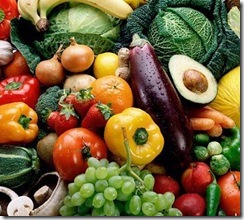 I’ve been challenging people to eat more fruits and vegetables this year (trying to encourage rather than nag). I grin to myself when I do this. It’s not a new idea. Even my grandmother told me these are “good for you.” She was right…but I don’t think that she had any idea of just how right she was.
I’ve been challenging people to eat more fruits and vegetables this year (trying to encourage rather than nag). I grin to myself when I do this. It’s not a new idea. Even my grandmother told me these are “good for you.” She was right…but I don’t think that she had any idea of just how right she was.
As a nutrition expert, I do my best to stay on top of the latest research, trends and opinions – not an easy task, as new information seems to emerge daily. I study the metabolic pathways and various physiological systems of our bodies, and the effects of various nutrients, eating trends, diseases, and exercise habits on them. I look at the biochemistry of phytochemicals, the claims and research about how they may or may not benefit our health, longevity and sport performance. I listen to my clients, colleagues and adversaries and do my best to hear with an open mind what all are saying – what the latest beliefs, experiences and trends are. Then I weigh this against the available research and my sage wisdom and experience, and come to the best educated conclusions I can. I then try to translate it all into practical recommendations for my patients and clients. What goes through my brain is biochemistry, endocrinology and exercise physiology mumbo jumbo….what comes out of my mouth is “eat a variety of fruits and vegetables.” Grin.
Let me give you a few reasons why I’m such an advocate for eating fruits & veggies:
- They are high in potassium,which plays a key role in regulating blood pressure. When the balance of sodium and potassium is “out of whack” blood pressure can go too high or too low. The popular trend is to pick on sodium, but the truth is that if people ate more plant-based foods (good sources of potassium), they wouldn’t need to restrict sodium as much. Additionally, athletes need potassium to replace that which is lost in sweat – this helps keep electrolytes balanced, the heart beating, and muscles from cramping. Any fruit or vegetable is a good source of potassium – did you know a potato has more potassium than a banana?
- They are high in fiber. Fiber keeps us regular – keeps things moving through our intestines. This not only keeps us more comfortable, but gives less opportunity for our bodies to be exposed to carcinogens or other toxins that are on their way out of the body. A fiber-rich diet also helps control cholesterol and blood sugar, and increases satiety so that we get full faster and are less likely to over-eat. (see list of fiber content of foods)
- They are packed with vitamins.Most fruits and vegetables are very nutrient dense – they have a lot of nutrition per calorie. They are great sources of vitamins A, E, K, thiamin (B1), riboflavin (B2), Niacin (B3), pyroxidine (B6), folate (B9), B12, Pantothenic acid (B5), biotin (B7), and vitamin C. Not all contain the same vitamins, but by eating a variety of different colored fruits & veggies, you are likely to get a good variety of vitamins.
- They contain phytochemicals.These are chemical compounds that are naturally occurring in plants which are believed to have a variety of health benefits. New research is emerging every month espousing the positive health effects of phytochemicals. Some phytochemicals are believed to ward off cancer, others are potent anti-oxidants believed to ward off aging. Some have anti-inflammatory properties which may help athletes heal and reduce delayed onset muscle soreness that comes with training. Still others may help decrease symptoms of asthma or help prevent degenerative eye diseases. We are only beginning to discover the potential of these health-boosting chemicals. Interestingly, many of these phytochemicals don’t have much effect by themselves (when isolated from the plant) but appear to work together (synergistically) with other phytochemicals. Which brings me back to my original admonition… eat a variety of whole fruits and vegetables.
The advice is simple, the rationale more complex. But the good news is that it is not difficult to include a variety of plant-based foods in our diets. Try these easy tips to get started:
- Start by adding fruit (fresh, frozen or dried) to every breakfast, to lunch and as a snack each day.
- Make sure you have veggies in both lunch and dinner – and work towards having more than one variety at each of these meals.
- Mix veggies into scrambled eggs, and add fresh or dried fruit to oatmeal or dry cereals.
- Put sliced vegetables on sandwiches and/or pack a salad full of colorful veggies and legumes for lunch.
- Have at least 2 types of veggies for dinner (example: sweet potato & broccoli, salad and grilled veggies, green beans, tomatoes & onions)
- Try to include legumes as a regular part of your meals as well (lentils, black beans, split peas, garbanzo beans, etc.).
It takes a little fore-thought when getting started but once the habits are formed, having a diet filled with whole fruits & vegetables is a fairly easy task. Oh, and by the way, contrary to popular belief, it’s not necessarily more expensive. Including seasonal produce and decreasing processed foods may actually save you money on your groceries. And will likely save you money on medical expenses in the long run.
** See if you can include at least 7 servings of fruits and/or vegetables each day. And remember, the greater the variety, the greater the benefit. Eat your colorful (plant) foods!
How much is in a “serving” of fruits or vegetables?
- ½ cup of fresh fruit or fruit juice
- ¼ cup dried fruit
- ½ cup of cooked vegetables
- 1 cup of raw vegetables
- 2 cups salad greens
- ½ cup vegetable juice

